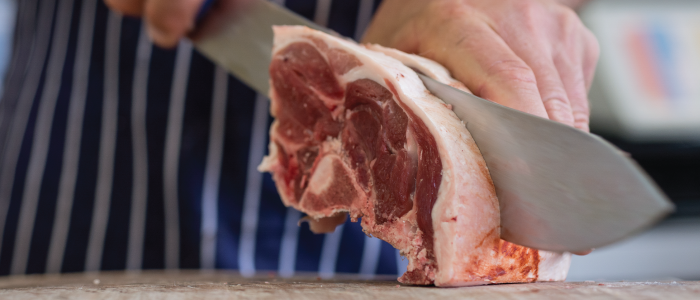5 essential knife skills every butcher should know
To the untrained observer, cutting meat is one of those skills that seems so simple that anyone could do it. But then, that’s the beauty of it – all the very best butchers are those can make the task look truly effortless, and the first step to achieving that is mastering the industry’s essential knife skills. This week, we’re looking at a couple of those core skills in detail, as well as some additional techniques for certain cuts of meat in particular. Even if you’re an experienced butcher, it’s worth giving them a read – you might still learn a few shortcuts!
The essentials of butchery knife techniques
Remember, always use the knife that’s been designed for the job. Don’t just make do with another, because that’s how they can get blunted and broken. Plus, you need to have total control over the blade at all times, and the easiest way to do that is by using the butcher’s knife that’s been specifically designed for the task at hand.
1. The Best Way To Hold Your Knife
We’ll start with the best way to hold the blade correctly. It might sound simple, but you may be surprised at how many butchers still get it slightly wrong! Besides, holding the blade incorrectly can not only affect your ability to properly cut up the meat, but in the worst case scenarios you can even end up hurting yourself.
Pick the knife up by the handle, with your dominant hand (so your right hand, if you’re right handed). Your index finger should be flat, not bent, and placed along the spine of the blade. Then simply curve your other three fingers and thumb around the handle, and make sure you’ve got a firm grip. Your other hand is then free to move the meat towards your blade as you cut it up.
If you’re worried about cutting the fingertips of your off-hand, experts recommend curling your fingers under your palm, exposing your flattened knuckle to the blade. On the other hand, you can save yourself the bother with our chain mail gloves, which have been designed with explicitly these sorts of scenarios in mind.
2. Slicing Your Meat – Why It’s Better To Slice Against The Grain

Amateur or inexperienced cooks often compare slicing meat to slicing vegetables, but in fact the two foodstuffs almost always require very different techniques. Many fine general slicing techniques (for example, a chiffonade) are ideally suited for small delicate vegetables or herbs, rather than tougher slabs of meat. Some individual butchers have developed their own personal takes on slicing techniques for meat, but one golden rule always holds true – always slice against the grain. This is because it’s not just the cut of the meat itself that determines how tender it is, but also how it’s cut.
The ‘grain’ in this context refers to the direction in which the muscle fibres are aligned. You should always take a second to identify this before you start cutting, as it can make all the difference between beautifully tender meat or one that is tough and chewy. By finding the direction of the grain and cutting against it (or across, as some people see it), you’re cutting through the muscle fibres and shortening them, which makes the meat more tender. Essentially, it’s easier for the end consumer to chew through the meat, because most of the hard work of breaking up those muscle fibres has already been done for them. If you were to cut with the grain – or parallel to it, in other words – those muscle fibres would be left more intact, which means more chewing would be required to properly break them down.
Excellent examples of specialised meat cutting techniques
Most of the more specialised methods of preparing meat build upon the basic slicing technique we’ve just outlined above, but even from experienced butchers, they still require a careful eye and usually a bit of practice to attain perfect results. Here are four of the most useful butchery techniques that all butchers should have in their repertoire.
1. How To Master Bias Cutting
Specially for meat, this method of cutting is ideal for producing flavourful, tender bite-sized pieces of meat that cook in no time at all. For commercial chefs, this makes it a particularly favoured technique for preparing meat for dishes like fajitas and stir fry.
To end up with cuts of meat around 3cm thick, begin by placing them in the freezer for around one hour. This is common practice for many butchers, as partially frozen meat is much easier to work on the cutting board. Once you’ve taken it out, place your knife or cleaver at a 45-degree angle to the surface of the meat, and then cut across the grain (as we discussed above) until you’re left with thin slices. If you need to go even thinner, you can stack several of your slices together and cut them in smooth strokes until they’re matchstick thin.
2. The Most Efficient Way Of Cubing Poultry and Fish

With enough practice under your belt, this can be an exceptionally quick job. First remove any skin, easily-separated fat and bones from your poultry or fish, then trim the tendons away using a paring knife. Next, freeze them partially using the same method we’ve touched on in the Bias Cutting entry above. Take it out, then place your knife at a 90-degree angle with the surface of the meat (straight down). Don’t forget to cut across the grain! Identify the direction of the grain, align your knife directly across it, and cut your meat into 2.5cm strips as you work your way across. Then, finish off by cutting them into 2.5cm cubes. You should be left with more or less perfect cubes, which will be excellent at holding their shape when cooking.
3. De-Boning A Chicken Breast
Obviously, you’ll need your de-boning knife, and possibly a bit of time set aside, as this can often be an especially fiddly task. Start by placing your chicken breast skin-side up on the cutting board, then set to work pulling the skin and subcutaneous fat away. Then, carefully insert your boning knife between the breast and the chicken’s sternum, and smoothly cut the meat away from the breastbone. Make sure you stay close to the sternum as you do so. After that, press the flat of the blade against the rib bones, and use a back-and-forth sawing motion to cleanly cut the meat away from the bones. That’s all there is to it!
You may well develop your own variations on these techniques, depending on your own experience and level of expertise. We’ll leave the specifics to you – here at Butcher’s Equipment Warehouse, our mission is to keep you equipped with the very finest quality knives, sharpeners and meat mincers (to name just a few examples!). You can start browsing our full stock of butcher’s knives here, or visit our Blackburn warehouse to weigh up our inventory for yourself.




